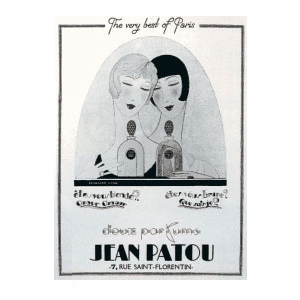In 1925, the world was basking in the opulence and exuberance of the Roaring Twenties. This decade was marked by significant cultural and social transformations, particularly in urban centers. The aftermath of World War I brought about a desire for joy, freedom, and indulgence. The era saw the rise of jazz music, flapper fashion, and a general sense of breaking away from the rigid norms of the past. Women were experiencing newfound freedoms, both socially and economically, allowing them to explore identities that were previously restricted. The spirit of the times was one of celebration, spontaneity, and a fervent pursuit of pleasure and romance.
Jean Patou's introduction of three fruit-floral fragrances—Amour Amour, Que Sais-Je?, and Adieu Sagesse—was a groundbreaking concept that aimed to encapsulate the stages of love. Each fragrance was designed to evoke different emotional states and experiences associated with love, creating a narrative journey through scent.
Amour Amour (Love, Love): This fragrance represented the initial, passionate stage of love. It was designed to capture the intoxicating and exhilarating feelings of infatuation and desire. The scent likely featured bright, vibrant top notes and lush, blooming florals to evoke the sensation of new, blossoming love.
Que Sais-Je? (What Do I Know?): This fragrance symbolized the contemplative and questioning phase of love. It reflected the moments of uncertainty and introspection that often accompany deeper emotional connections. The scent would have had a more complex composition, perhaps with a mix of fruits and florals layered with subtle, introspective undertones, evoking the complexity and nuances of a developing relationship.
Adieu Sagesse (Goodbye Caution/Farewell Wisdom): Representing the stage where caution is abandoned, "Adieu Sagesse" embodied the fearless and uninhibited embrace of love. This fragrance was designed to be bold and seductive, capturing the essence of passionate, unreserved affection. It likely combined rich, opulent floral notes with warm, inviting undertones, creating a scent that was both alluring and memorable.
Jean Patou’s choice of the name "Adieu Sagesse" was likely influenced by the cultural climate of the 1920s, which celebrated liberation and self-expression. By naming the perfume "Adieu Sagesse," Patou encapsulated the essence of the era—a bold departure from traditional values in favor of embracing the passions and pleasures of life. The name suggests a fragrance that embodies the spirit of adventure and the willingness to take risks in the realm of love and romance.
"Adieu Sagesse" is an excellent name for a perfume because it conveys a sense of intrigue, allure, and emotional depth. It suggests a fragrance that is bold and evocative, one that encourages the wearer to step out of their comfort zone and embrace the excitement of the unknown. The name is poetic and resonates with the idea of living life fully and passionately, making it an appealing choice for a perfume.
The phrase "Adieu Sagesse" evokes images of moonlit rendezvous, secret trysts, and passionate embraces. It conjures emotions of excitement, freedom, and the thrill of the unknown. There is a sense of rebellion against the mundane and a celebration of the intensity of romantic love. The name suggests a journey into uncharted territories of the heart, where wisdom and caution are left behind in favor of pure, unbridled emotion.
"Adieu Sagesse" is a unique name for a perfume, distinguished by its poetic and evocative nature. It stands out in its ability to convey a narrative and emotional depth that resonates with those seeking more than just a fragrance but an experience. The phrase can be interpreted as an invitation to embrace life's passions fully and without hesitation, making it a compelling choice for a perfume.








